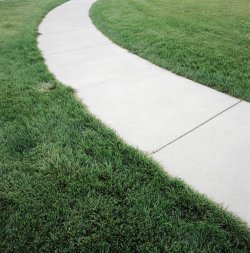

To send a message to an author, click on the author's name at the end of the article.
This Month in Ag Connection | Ag Connection - Other Issues Online

Last winter, I was fortunate enough to be invited on a 2-week study trip to Australia and New Zealand looking at their grass based dairy industry. One of the things I was really impressed by was how those producers planned ahead. They developed strategies for various situations well in advance of occurrence. This allowed them to take a more objective look at how they would respond to a situation before it occurred, rather than to make a hasty decision in the midst of a situation. Then they had the discipline to act on the appropriate strategy when the time came. How is this useful to Missouri producers and why should you care what a dairy producer halfway around the world does? Perhaps the following information will get your attention.
I have developed several example rations for backgrounding beef calves on hay diets using corn, soybean meal, soybean hulls, dried distiller's grains and corn gluten feed in various combinations and feeding rates. Occasionally, I will calculate the cost of these rations using current ingredient prices. I decided to take a look at these since it had been a few weeks since I checked out the prices for the various by-product feeds.
Bottom line is, if you are planning on using corn gluten feed or soybean hulls next winter, you should strongly consider purchasing at least some of those ingredients now. Local retail prices are listed in the $120 per ton range for both of these ingredients. Let's translate those costs into actual feed costs for growing calves. Based on the nine rations I have calculated, feed cost per head per day ranged from $.80 to $1.08 for the same rate of gain. This makes cost per pound of gain range from $.37 to $.53. For 200 pounds of gain, feed costs range from $74.60 to $106.40, or a difference in feed cost of $31.80 per head depending upon which combination of feed ingredients were used to obtain the same amount of gain.
Considerations for planning:
Let me try to answer a few of these questions. If you typically background your weaned calves and have the forage on hand to do so, I would suggest you take a serious look at several feeding programs and try to lock in at least some of your feed needs now. At least that allows you to control one variable in the production system - feed costs. If you have never used any of the by-product feeds, would a feed savings in the range of $30 per head entice you to take a look at using those ingredients? (How do you know prices lower now...later?)
I would also give the same advice to cow-calf producers who use by-product feeds. Try to lock in at least some of your winter feed needs now while prices are low. If you need assistance with rations or have other feeding questions, contact your local MU Extension Livestock Specialist.
Source: Gene Schmitz, MU Extension Livestock Specialist)
This Month in Ag Connection | Ag Connection - Other Issues Online
As harvest gets closer, combines will be prepared for the upcoming fall season. It is important for those who are using yield monitors to start thinking about getting them ready for their data collection task. An investment of time now can go a long way toward preventing loss of data or downtime during the busy harvest season. Here is a checklist for calibrating your yield monitor. (Please note that these steps will vary according to your yield monitor's manufacturer.)
Steps to Take Before Going to the Field

In-field Calibration Steps

Recheck Calibration During Harvest Season
Calibration of your yield monitor should be repeated or checked if major differences in harvest conditions are encountered. Although the manufacturers' recommendations vary, Pioneer Hi-Bred International, Inc. suggests the following rules for re-calibration when harvesting corn hybrid trials.
Re-calibrate if one of the following occurs:
Source: Kent Shannon, MU Extension Natural Resource Engineer Specialist)
This Month in Ag Connection | Ag Connection - Other Issues Online
In Missouri, cool-season grasses like Kentucky bluegrass, tall fescue and perennial ryegrass typically face disease pressures, drought, insects and the reduction of root mass due to the effects of high heat. Many times lawns may appear thinned out, indicating a need for some fall renovation or overseeding. Our night temperatures will begin to dip into the sixties once again and possibly the fifties at the end of summer (late Aug./early Sept.). We will begin to receive more significant rainfalls and the battle with summer annual weeds will come to a close with the first frost of fall. Therefore, it's that time of the year again, when our coolseason grasses will start to thrive and recover. It's also the best time of the year to plant new seed, open up the soil, and begin fall fertilization.
A quality lawn containing the recommended mixtures of species or blends of turfgrass varieties can be a difficult decision. Selecting species of turfgrasses is dependent on how you manage your lawn and what you expect of your lawn. Managing a lawn involves frequency of mowing, how often you fertilize, will you water your lawn and will you use crabgrass preventers and/or products to control turfgrass diseases and insects. Once you know the answers to these questions, then you can decide which specie, or mixture of species, will work for you.

Selecting Turfgrasses
Blends of Kentucky bluegrasses look very rich with dark blue-green colors, have pretty good resistance to brown patch disease, however, they do require more inputs of fertilizer and water to maintain that rich cover through the summer months. They are also more susceptible to dollar spot, leaf spot and summer patch diseases. Selecting bluegrass varieties that offer some resistance to some of these diseases is a practical first step in lawn establishment. Bluegrasses do develop tillers and small rhizomes, which allow bluegrasses to recover from thinning or other problems.
Blends of turf-type tall fescues can give deep emerald green appearances with a slightly coarser texture than the bluegrass. They tend to be a deeper rooting plant, therefore requiring less water than the bluegrasses. They are not as susceptible to dollar spot and summer patch, but generally will require fungicides for the control of brown patch. There are several varieties of turf-type tall fescues that offer better resistance to brown patch than other varieties, therefore selecting the more resistant varieties will improve turf quality. Tall fescues will tiller to help with recovery, but tend to be clumpy with severe thinning.
Mixtures, such as turf-type tall fescues with bluegrasses (90 percent fescue, 10 percent bluegrass), combine the advantages of each species to mask the weaknesses of each. Mixtures with perennial ryegrass should not exceed 20 percent perennial ryegrass as it is very susceptible to most of the diseases list above. Ryegrass is not very heat or drought tolerant and does not recover from thinning of cover. Unfortunately, many seed mixtures and blends available to homeowners at local garden centers contain large amounts of ryegrass (both annual and perennial) and fine leaf fescues (creeping red fescues, hard fescues, etc.). Fine leaf fescues have very little tolerance to direct sunlight. They easily burn out.
So which varieties do you select once you decide on a blend or mixture? There are many resources available that list turfgrass varieties for Missouri. State turfgrass specialist, MU guide sheets, garden centers and other lawn care experts are good sources for information about turfgrass selections and varieties. The difficulty for most individuals is trying to find the varieties suggested. Lowe's, Home Depot, hardware stores and other garden centers cannot carry all of the premium varieties. Sometimes the easiest approach is to list what they have and then cross-reference to the varieties listed for our area. MU's guide sheet #6772, "Cool-Season Grass Cultivars For Athletic Fields," has excellent, good and fair listings for Kentucky bluegrass, tall fescue and perennial ryegrass. While the guide sheet is written for athletic fields, the listings are excellent for home lawns as well. Information for selecting varieties can also be found through the National Turfgrass Evaluation Program (NTEP) Website at http://ntep.org for those who are comfortable searching the web. NTEP provides data tables for all turfgrass species for a number of different characteristics (quality, density, color, disease resistance, wear resistance, etc) from best to worst, averaged nationally and by location, specifically Missouri. Therefore, selecting varieties that will grow best in Missouri can be determined through a number of reliable resources.
The key to a quality lawn is to select turfgrass species and varieties that will grow best in Missouri. Finding those varieties that will offer good quality, color, density and disease resistance will make your task of lawn care a little easier. Hopefully, the selection process will become less difficult as you search the shelves of your local garden centers and nurseries.
Lawn Renovation
Typical summer heat and humidity through July and August has many of us wondering why we even try to maintain cool-season grasses such as Kentucky bluegrass and turftype tall fescue in our home lawns. Yet the aesthetics of cool-season grasses keep us focused on that annual ritual of renovation and over-seeding. Establishment of turfgrass brings beauty and value to any landscape and the success of a beautiful turf is dependent on many factors.
As August gives way to September, we are entering the optimum time of the year to establish our cool-season turfgrasses. Labor Day weekend is usually an excellent time to start preparations for seeding. General steps to successful turfgrass establishment include several items.

First, obtain a soil fertility test for fertilizer recommendations. Knowing which nutrients are sufficient and which ones are needed will determine optimum fertilizer needs. The pH of the soil is also important to know and a pH range of 6.5 to 6.8 is excellent for turf establishment. Any lime requirements to raise pH will be specified on the soil test results. Having this information in hand prior to seeding can save you time and money when trying to establish turfgrasses. Starter fertilizers (e.g. 10- 24-18) are usually recommended at a rate of one pound of nitrogen per 1,000 square feet at time of seeding, but again this is dependent on your soil test results.
Preparation of the site includes the removal of any debris such as rocks and a visual inspection to make sure the grade or slope of your landscape is adequate for good surface drainage. Holes from rock removal or low water holding pockets need to be filled in to insure proper drainage. Poorly drained areas are detrimental to maintaining healthy turf. Site preparation should also include any broadleaf weed control, if infestations are high. Perennial broadleaf weeds such as dandelion and plantain should be controlled at this time of the year. Trimec or Weed-B-Gone are excellent over-the-counter products available to homeowners. Labels for these products usually recommend three weeks between spraying and seeding, therefore start early if controlling broadleaf weeds first.
If you choose to renovate your lawn to different species of turf (bluegrass to fescue or vice versa), an application of Roundup is needed to kill out the old turf. Roundup herbicide can be purchased at any home and garden center and be sure to follow the label for application instructions. In seven to ten days a second application may be necessary to pick up any areas missed in the initial application. If your old lawn is totally brown, then soil prep and reseeding can take place seven days after the final application of Roundup.
If your lawn only requires over-seeding to fill in thinned areas or small spots from summer disease or drought, then Roundup is not required and seeding can proceed.
When seeding, it is important to have good seed/soil contact to improve seed germination. If you choose to renovate with Roundup, you have the option to till the soil and create a fine seedbed. When tilling the soil, straw will be needed to prevent erosion at a rate of one bale per 1,000 square feet. Other methods to insure good seed/soil contact include a power rake or vertical mower. These types of equipment work up the top ½ inch of soil and can be used for complete or partial renovations. The best method of planting seed is with the use of a slit seeder. This piece of equipment actually plants the seed in the soil about ¼" deep. Again you have better seed germination and less chance of the seed washing away in a heavy rain. Equipment of these types can usually be rented at any local rental or hardware store.
Seeding rates for Kentucky bluegrass should be about 2 to 3 pounds per 1,000 square feet. Turf-type tall fescues can be seeded around 6 to 7 pounds per 1,000 square feet. Mixtures of tall fescue with Kentucky bluegrass should be seeded at 6 to 9 pounds per 1,000 square feet. Seed applications following tillage, power raking or vertical mowing should be raked in lightly to help cover the seed with soil.
The final step to a successful lawn renovation is proper watering. The first two weeks following seeding is the most critical. Until the seed germinates and starts to put down a root, seed can wash away very easily. You should keep the soil surface moist, not wet. Do not let seed dry out once it starts to germinate. On warm, windy days with lower humidity, it may require several light waters a day to keep the surface moist. Always avoid puddling and runoff.
In a successful renovation, seedling turfgrass should be up and growing in 10 to 14 days. If your renovation takes place in the first half of September, you will be mowing your new lawn once or twice late in the Fall. One month after you notice new seedlings, we recommend an additional fertilizer application of one pound of nitrogen per 1,000 square feet of a good, complete fertilizer (e.g., 24-4-12). Our recommended Fall seeding program can start Labor Day weekend until October 15 in some years.
Source: Brad S. Fresenburg, MU Extension/Research Associate Turfgrass Research)
This Month in Ag Connection | Ag Connection - Other Issues Online

Many families are right in the middle of county and state fair activities and kids are or will be calculating their earnings from their 4-H or FFA projects. While the net income from 4-H or FFA projects will have to be reported for income tax purposes - if the youngster is required to file a tax return, the earnings may not be subject to self-employment tax (i.e. Social Security and Medicare taxes). If the project was entered into primarily for educational purposes, rather than for profit, and was completed under the rules and economic restrictions of the sponsoring 4-H or FFA organization, net income from the project will not be subject to self-employment tax.
For the majority of children these projects are not entered into with the intent of developing a trade or business, thus the income is not considered self-employment income. However, if the 4-H or FFA projects were entered into for the purpose of developing a trade or business, then the income from the activities would be subject to self-employment tax if the amount of net income is $400 or greater. Each case will need to be evaluated based on its own facts and circumstances. While most children participating in these 4-H and FFA projects hope to make money, their primary reason for participating in these projects is generally educational.
If the activity is not a trade or business, do not report the income and expenses on the Schedule F "Profit or Loss from Farming". Instead report the net income from this activity on Line 21, "Other income", on Form 1040. Attach a statement listing the gross income and expenses associated with the activity along with a statement indicating this activity is a 4-H or FFA educational project.
Source: Parman R. Green, MU Extension Ag Business Mgmt. Specialist)
This Month in Ag Connection | Ag Connection - Other Issues Online
Publishing Information
Ag Connection is published monthly for Northeast and Central areas of Missouri producers and is supported by the University of Missouri Extension, the Missouri Agricultural Experiment Station, and the MU College of Agriculture, Food and Natural Resources. Managing Editor: Mary Sobba.